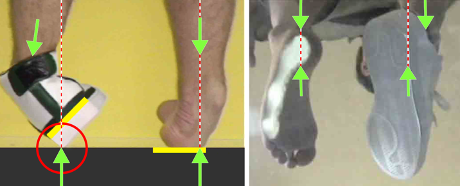UNNATURAL INSTABILITY:
Shoe Sole Structures Have a Major Stability Defect, Extremely Dangerous and Costly, But Correctable
The structures of athletic and other shoe soles have an unnatural stability defect. Shoes are highly unstable when tilted-out into the all-too-typical ankle spraining position. In stark contrast, the barefoot has solid natural stability in the same ankle spraining position. The natural stability of the barefoot proves the shoe’s instability is artificial and therefore likely avoidable.

Ironically, the primary casualty of the shoe’s artificial instability – the frequently damaged human ankle – is incorrectly blamed for that instability. The victimized ankle has been mistakenly maligned as a weak link in human evolution. Instead, true blame obviously lies with the unnatural stability defect in the structure of shoe soles, even though that unexpected reality has been hidden in plain sight for at least 2,000 years
The sole defect appears to cause an estimated 20,000 deaths, 700,000 hospitalizations, 3,200,000 Emergency Room visits, and $65 billion in medical costs each year in the U.S. alone, based on CDC data. Nearly all can be prevented with stability corrections in shoe sole structure based on proven existing technologies that are available for free and open public use.
Those design corrections can quickly reduce the safety defect and eliminate it over time without undue difficulty. The end result will be redesigned shoe soles that restore the true natural foot and ankle stability provided by the sole of the barefoot, and are also much more comfortable. The far better stability and comfort are so noticeable that shoe sales should increase substantially, easily offsetting a shoe company’s relatively low cost of finally making its footwear products safe for customers.